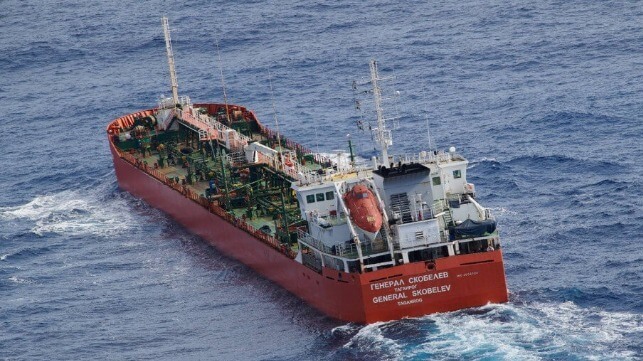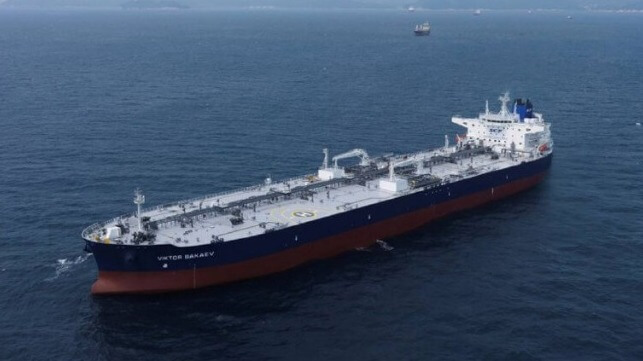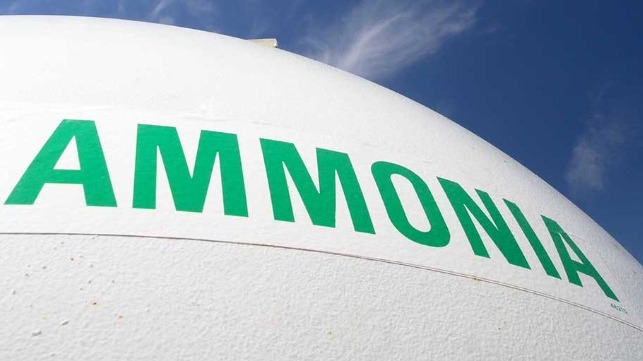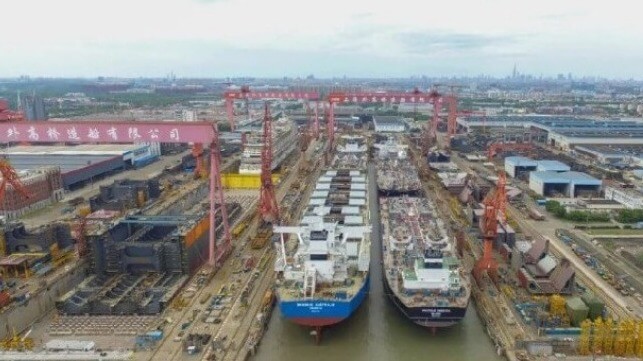Oliver Milman and Dharna Noor
Thu, 16 May 2024

Donald Trump in Nashville, Tennessee, on 22 February 2024
A “deal” allegedly offered by Donald Trump to big-oil executives as he sought $1bn in campaign donations could save the industry $110bn in tax breaks if he returns to the White House, an analysis suggests.
The fundraising dinner held last month at Mar-a-Lago with more than 20 executives, including from Chevron, Exxon and Occidental Petroleum, reportedly involved Trump asking for large campaign contributions and promising, if elected, to remove barriers to drilling, scrap a pause on gas exports, and reverse new rules aimed at cutting car pollution.
Congressional Democrats have launched an investigation into the “ethical, campaign finance and legal issues” raised by what one Democratic senator called an “offer of a blatant quid pro quo”, while a prominent watchdog group is exploring whether the meeting warrants legal action.
But the analysis shared with the Guardian shows that the biggest motivation for oil and gas companies to back Trump appears to be in the tax system, with about $110bn in tax breaks for the industry at stake should Joe Biden be re-elected in November’s election.
Biden wants to eliminate the tax breaks, which include long-standing incentives to help drill for oil and gas, with a recent White House budget proposal targeting $35bn in domestic subsidies and $75bn in overseas fossil fuel income.
“Big oil executivess are sweating in their seats at the thought of losing $110bn in special tax loopholes under Biden in 2025,” said Lukas Ross, a campaigner at Friends of the Earth Action, which conducted the analysis.
Ross said the tax breaks are worth nearly 11,000% more than the amount Trump allegedly asked the executives for in donations. “If Trump promises to protect polluter handouts during tax negotiations, then his $1bn shakedown is a cheap insurance policy for the industry,” he said.
Some of the tax breaks have been around for decades, and are a global issue, but the US oil and gas industry benefited disproportionately from tax cuts passed by Trump when he was president in 2017.
Next year, regardless of who is president, a raft of individual tax cuts included in that bill will expire, prompting a round of Washington deal-making over which industries, if any, will help fund an extension.
Lobbying records show that Chevron, Exxon, ConocoPhillips, Occidental, Cheniere and the American Petroleum Institute (API) have all met lawmakers this year to discuss this tax situation, likely encouraging them to ignore Biden’s plan to target the fossil fuel industry’s own carve-outs.
Chevron and ConocoPhillips, the analysis shows, lobbied on a deduction for intangible drilling costs, the largest federal subsidy for US oil and gas companies, which is worth $10bn, according to federal figures.
Other lobbying centered on more generalized tax breaks that the oil and gas industry has taken advantage of. ExxonMobil lobbied for a little-known bill that would restore a bonus depreciation deduction to its full value, which, according to Moody’s, would allow big oil to avoid Biden’s newly established corporate minimum tax.
“Unlike previous administrations, I don’t think the federal government should give handouts to big oil,” Biden said following his inauguration in 2021. But Congress and the president will have to agree to any new tax arrangements next year, and the fossil-fuel industry continues to have staunch support from Republicans and some Democrats.
The API insisted its industry gets no favorable treatment in the tax system. “America’s energy industry proudly invests in communities, pays local, state and federal taxes and receives no special tax treatment from the federal government,” an API spokesperson said.
“This nonsense report is another attempt to distract from the importance of all energy sources – including oil and natural gas – to meet America’s growing energy needs.”
Who was at Mar-a-Lago?
The high stakes for the fossil-fuel industry, as well as for the climate crisis, have placed scrutiny upon those who attended Trump’s dinner at Mar-a-Lago. Although representatives of large oil companies were present, the majority of known attendees were executives of smaller firms focused on specific subsections of the fossil-fuel industry, such as fracking or gas exporting.
Those companies are not often held to account in international forums such as the UN climate talks or the Oil and Gas Climate Initiative, which means they are less likely to make buzzy climate pledges. They may also be more threatened by regulations on individual parts of the US fossil fuel economy, such as auto-emissions standards aiming to quell gas-car usage.
“The oil majors … see their future in plastic [production]. That doesn’t apply to the smaller companies who don’t work across the industry,” said Kert Davies, director of special investigations at the Center for Climate Integrity. “They’ve got nothing to shift to.”
Among other reported attendees were the head of the company Venture Global, which rivals Qatar as one of the world’s leading liquefied natural gas exporters. This year, the company came under fire after it was revealed to have been using millions of gallons of water to construct a Louisiana LNG terminal while a nearby community faced extreme shortages. The firm was also accused late last year of reneging on its contracts by Shell and BP.
Another attendee: Nick Dell’Osso, CEO of Chesapeake Energy, which after years of court fights had to pay $5.3m to Pennsylvania landowners who say they were cheated out of gas royalties. The company’s earlier CEO, John McClendon, was indicted in 2016 on charges of conspiring to rig bids on oil and gas leases in Oklahoma.
Billionaire oil tycoon Harold Hamm, who founded fossil fuel exploration company Continental Resources, was also present. He helped raise money for Trump’s 2016 presidential run and was under consideration to be Trump’s energy secretary, and was reportedly one of the seven top donors who had special seats at Trump’s inauguration. Though he eschewed the former president after his 2020 loss, he donated to his primary campaign in August.
Asked about the meeting, API spokesperson Andrea Woods said the organization “meets with policymakers and candidates from across the political spectrum on topics important to our industry”. She said the premise of Democrats’ investigation into the meeting is “patently false and an attempt to distract from a needed debate about America’s future – one that requires more energy, including more oil and natural gas”.
Amid the scrutiny of last month’s Mar-a-Lago dinner, Trump is continuing to court oil-tied funders. On Tuesday evening, he held a Manhattan fundraising dinner that cost a minimum of $100,000 to attend.
Among the event’s hosts, advocacy group Climate Power noted, was John Catsimatidis, the chief executive of the much-scrutinized gas refiner United Refining Company and owner of two grocery chains, a radio station and holding company Red Apple Group.
Between 2017 and 2023, United Refining Company’s small refinery in western Pennsylvania was the most dangerous refinery in the country, with federal data showing it reported 10 times the average number of injuries for a refinery – 63% higher than the next-most dangerous facility.
The company also reportedly sought to dodge environmental regulations using a process championed by Trump’s EPA administrator Scott Pruitt.
Catsimatidis has also been criticized for neglecting vacant gas-station properties and for blaming gas prices on “open” borders, corporate taxes and worker benefits. The Pennsylvania town home to United Refining pays some of the highest gas prices in the state, despite the presence of the refinery, raising suspicions among some residents about the company’s practices.
Trump this week also held a fundraiser hosted by the US senator JD Vance, who is one of the largest recipients of big-oil funding in Congress, and another with Joe Craft, a major Trump donor who owns massive coal producer Alliance Resource Partners. In 2016, Craft reportedly gifted Pruitt courtside basketball tickets after the agency crafted pro-coal regulations.
11,000% Return: Trump’s $1 Billion Offer Could Yield $110 Billion Windfall for Big Oil

A new analysis reveals that the alleged $1 billion election year “quid pro quo” offer that presumptive Republican nominee Donald Trump made to executives of major oil company’s could, if they agreed to the deal, bank them a handsome profit.
According to the study by Friends of the Earth Action, first reported by The Guardian on Thursday, the “remarkably blunt and transactional” offer from Trump—in which $1 billion in campaign funding put together by the nation’s major oil companies would be repaid upon his election with massive deregulation of the oil and gas sector as well as tax relief for the industry—would yield a major windfall for those same corporations, including an estimated $110 billion from the tax breaks alone.
As The Guardian reports:
Biden wants to eliminate the tax breaks, which include long-standing incentives to help drill for oil and gas, with a recent White House budget proposal targeting $35bn in domestic subsidies and $75bn in overseas fossil fuel income.“Big oil executivess are sweating in their seats at the thought of losing $110bn in special tax loopholes under Biden in 2025,” said Lukas Ross, a campaigner at Friends of the Earth Action, which conducted the analysis.
Ross said the tax breaks are worth nearly 11,000% more than the amount Trump allegedly asked the executives for in donations. “If Trump promises to protect polluter handouts during tax negotiations, then his $1bn shakedown is a cheap insurance policy for the industry” he said.
Republicans in Congress last year confirmed that if Trump wins back the White House and the GOP resume control of both chambers, they will move aggressively to make the Republican’s 2017 tax cuts, which largely benefited the wealthy and corporations, permanent. As some of the most profitable companies in the U.S., oil and gas companies stand to benefit greatly from that outcome.
In Florida last month, not long before his meeting with oil executives, Trump told a different crowd of “rich as hell” supporters gathered at Mar-a-Lago: “We’re gonna give you tax cuts, we’re gonna pay of our debt.” The problem with the second half of that claim is presented in a recent CBO report which found that another wave of tax cuts like those passed by the GOP in 2017 would skyrocket the national debt by an estimated $4.6 trillion over the next ten years.
Earlier this week, House Democrats, led by Oversight Committee Ranking Member Rep. Jamie Raskin (D-Md.), launched a probe into the “quid pro quo” allegations between Trump and Big Oil, including letters to company executives believed to have been in attendance.
The blatant nature of Trump’s corrupt intent, according to some political observers, is an opportunity that Democrats and champions of climate action and other progressive causes should not miss.
Writing about the circumstances in The New Yorker on Wednesday, journalist and veteran climate activist Bill McKibben argued that the stakes of this election are made plain in what Trump has offered the fossil fuel industry in exchange for its financial backing.
“Trump’s reported billion-dollar offer to fossil-fuel executives shows that this is the key year to save the planet,” McKibben writes.
“Given four years to finish the implementation of the Inflation Reduction Act, a second-term Biden Administration might finally be able to break the hold of fossil fuel’s political influence,” his essay explains. “Another term of Trump, however—and with all that it means for undercutting global efforts at climate regulation, as well—offers an entirely plausible and entirely opposite outcome: climate chaos combined with continued fossil-fuel dependence.”
What’s true, according to McKibben, is that the fossil fuel industry “might well decide that defeating Biden in November is worth a lot of money.” Citing recent profits by Chevron of $21 billion and ExxonMobil’s $36 billion, he said the oil giants will “definitely give Trump something, and the return on investment on that donation—if successful—would be better than the luckiest well they ever hit.”
The new analysis by Friends of the Earth Action shows that McKibben—once again—probably has the math right.

 Fig. 1: General Skobelev's route from April 21 to May 8, 2024. Sources: AIS data provided by Global Fishing Watch, annotated by the authors.
Fig. 1: General Skobelev's route from April 21 to May 8, 2024. Sources: AIS data provided by Global Fishing Watch, annotated by the authors.







